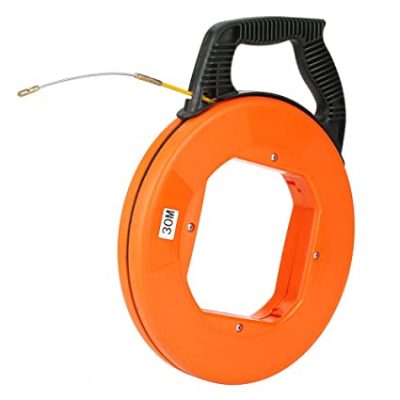Project Report For Fish Tape
Introduction
Project Report for Fish Tape is as follows.
The tape, which is made of a narrow band of spring steel, may be directed into limited locations such as wall cavities or conduits by careful manipulation. The purpose is to push towards a location inside the limited space where guide string has been dropped and draw it through, so that the guide string may subsequently be utilised to pull through various forms of wiring, such as phone wire.
To draw electrical or other lines through conduits, electricians commonly use fish tape. It is also used to pull NM wire through walls, ceilings, floors, and other difficult-to-reach areas. A piece of strong, flat steel wire is used to make the fish tape. Fish tapes are frequently held in place by a plastic reel. As a result of this, they have a natural curvature, and it is this curvature that allows them to be directed. The tape’s end can be directed slightly by adjusting the reel.
The tape is stiff enough that it can be pushed in the direction it is pointing. It can be easily guided through an empty wall cavity this manner. The usage of a fish tape is made more difficult by thermal insulation, firestops, lines, HVAC ducts, electricity connections, and other obstructions.
The fish tape is wrapped up and kept in a sphere-shaped plastic container. It is available in lengths of 25, 50, 100, and 200 feet. Although motorised fish tapes automatically reel in the tape, the fish tape must still be physically pulled out of the case and rolled back into it.

Uses Of Fish Tape
Start by unrolling a few inches of fish tape from the plastic housing. You may have to click a button to release the tape. Other types of fish tape do not have buttons and must be torn out. Push the fish tape forward to get it into the conduit or through the stud holes. Feed the tape till the other end is exposed for a foot or two. Remove the covering from the electrical cord to expose several inches of wire. Remove the wire ends to reveal the copper.
Combine the wires by twisting them together. Connect one of the wires to the fish tape end. Using the wire, create a complete loop. Wrap electrical tape tightly around the wires. Begin where the wires connect to the end of the fish tape and end where the cable sheathing starts. Wrap it securely. Use no more than one layer of tape at a time. Join the open end of the double loop to the end of the fish tape. If not, it may become stuck in couplings and pushed back. Gradually retract the fish tape. Slowly unwind the electric line as a helper unravels the other end.
Get Completely Custom Bankable Project Report
Market Potential Of Fish Tape
The Fish Tape market is predicted to develop at a 7.5% annual rate (CAGR 2023 – 2030).
The market for Fish Tape has expanded dramatically in recent years. The Fish Tape business has grown significantly as a result of technological improvements and rising demand for new products and services. The market for Fish Tape has expanded significantly, with more and more businesses entering the industry to capitalise on rising demand.
The market share of Fish Tape has also increased significantly. The industry is competitive, with firms trying to provide the finest products and services to their clients. The sector is extremely fragmented, with several competitors providing a diverse variety of products and services. Despite this, certain corporations have established a substantial presence in the industry and control a major portion of it.
Several factors are driving the growth of the Fish Tape market, including rising consumer demand, technological developments, and increased expenditures in research & development. The rising demand for Fish Tape products and services has resulted in a spike in market expansion, with an increasing number of firms entering the sector to capitalise on the potential.
Customers in the Fish Tape market include electricians, fishermen, construction workers, and others. Fish tapes are typically used by electricians to guide electrical wires through conduits and pipelines. These tapes are used by fishermen to clean or recover their fishing lines. Others utilise fish tapes for home improvement projects, education, and other high-precision applications that need stringing wires through narrow areas.

